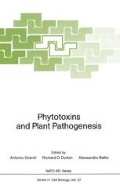Abstract
There are a number of plant diseases in which specificity is determined by the ability of the pathogen to produce toxins that are selectively active only on susceptible crop cultivars. Twenty to thirty years ago, diseases that involved so called host — selective toxins were considered to be curiosities. However, the long-term and independent efforts of H. Wheeler and R.P. Scheffer and their associates have led to an acceptance of these diseases as relevant models for the elucidation of molecular mechanisms of disease specificity. Genetically, these diseases are the inverse of the gene-for-gene relationship. There is a dominant gene in the pathogen controlling toxin synthesis and a corresponding dominant gene in the host plant that confers sensitivity to the toxin, presumably by coding for a receptor molecule. Thus, characterization of such diseases at the molecular level requires that both the toxin and the receptor, as well as their interaction, be characterized.
Access this chapter
Tax calculation will be finalised at checkout
Purchases are for personal use only
Preview
Unable to display preview. Download preview PDF.
Literature Cited
Daly JM (1981) Mechanisms of action. In: Durbin RD (ed) Toxins in plant disease, Academic Press, New York, p 331
Dunkle LD (1984) Factors in pathogenesis. In: Kosuge T, Nester EW (eds) Plant-microbe interactions, Macmillan Publishing Co., New York, p 19
Knoche HW, Duvick JP (1988) The role of fungal toxins in plant disease. In: Pegg GF, Ayres PG (ed) Fungal Infections of Plants, Cambridge University Press, p 158
Macko V, Wolpert TJ, Acklin W, Jaun B, Seibl J, Meili J, Arigoni D (1985) Characterisation of victorin C, the major host-se1ective toxin from Cochliobolus victoriae: structure of degradation products. Experientia 41:1366–1370
Mayama S, Tani T, Ueno T, Midland SL, Sims JJ, Keen NT (1986) The purification of victorin and its phytoalexin elicitor activity in oat leaves. Physiological and Molecular Plant Pathology 29:1–18
Meehan F, Murphy HC (1946) A new Helminthosporiurn blight of oats. Science 104:413–414
Meehan F, Murphy HC (1947) Differential phototoxicity of metabolic by-products of Helminthosporiurn victoriae. Science 106:270–271
Schauenstein E, Esterbauer H, Zollner H (1977) Aldehydes in biological systems — their natural occurrence and biological activities. Pion Limited, London, p 1–205
Scheffer RP (1976) Host-specific toxins in relation to pathogenesis and disease resistance. In: Heitefuss R, Williams PH (eds) Encyclopedia of Plant Physiology, vol. 4, Springer-Verlag, Berlin, p 247
Scheffer RP, Livingston RS (1984) Host-selective toxins and their role in plant disease. Science 223:17–21
Shain L, Wheeler H (1975) Production of ethylene by oats resistant and susceptible to victorin. Phytopathology 65:88–89
Walton JD, Earle ED (1985) Stimulation of extracellular polysaccharide synthesis in oat protoplasts by the host-specific Phytotoxin victorin. Planta 165:407–415
Wheeler HE, Luke HH (1954) Studies of a toxic agent produced by Helminthosporiurn victoriae. Phytopathology 44:334
Wolpert TJ, Macko V, Acklin W, Jaun B, Seibl J, Meili J, Arigoni D (1985) Structure of victorin C, the major host-se1ective toxin from Cochliobolus victoriae. Experientia 41:1524–1529
Wolpert TJ, Macko V, Acklin W, Jaun B, Arigoni D (1986) Structure of the minor host-selective toxins from Cochliobolus victoriae. Experientia 42:1296–1299
Wolpert TJ, Macko V, Acklin W, Arigoni D (1988) Molecular features affecting the biological activity of the host-selective toxins from Cochliobolus victoriae. Plant Physiol 87:37–41
Yoder OC (1980) Toxins in pathogenesis. Ann Rev Phytopathology 18:103–129
Author information
Authors and Affiliations
Editor information
Editors and Affiliations
Rights and permissions
Copyright information
© 1989 Springer-Verlag Berlin Heidelberg
About this paper
Cite this paper
Macko, V., Wolpert, T.J., Acklin, W., Arigoni, D. (1989). Biological Activities of Structural Variants of Host-Selective Toxins from Cochliobolus Victoriae . In: Graniti, A., Durbin, R.D., Ballio, A. (eds) Phytotoxins and Plant Pathogenesis. NATO ASI Series, vol 27. Springer, Berlin, Heidelberg. https://doi.org/10.1007/978-3-642-73178-5_4
Download citation
DOI: https://doi.org/10.1007/978-3-642-73178-5_4
Publisher Name: Springer, Berlin, Heidelberg
Print ISBN: 978-3-642-73180-8
Online ISBN: 978-3-642-73178-5
eBook Packages: Springer Book Archive

